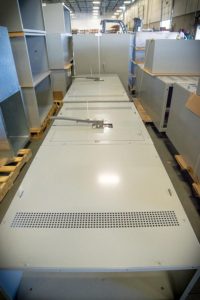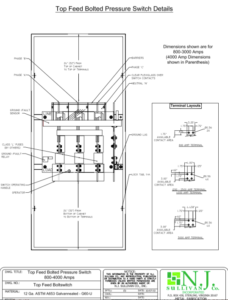 Bolted pressure switches are an important feature of an electrical distribution system. It is a common utility product in any medium or large building or facility, designed to safely switch on and off large electrical loads. It represents a facility’s main electrical incoming point for a building’s electrical distribution system. The amount of current a bolted pressure switch is designed to handle is often in the thousands of amps. The current passing through a bolted pressure switch is often equivalent to the current carrying capacity of a bolted buss-bar.
Bolted pressure switches are an important feature of an electrical distribution system. It is a common utility product in any medium or large building or facility, designed to safely switch on and off large electrical loads. It represents a facility’s main electrical incoming point for a building’s electrical distribution system. The amount of current a bolted pressure switch is designed to handle is often in the thousands of amps. The current passing through a bolted pressure switch is often equivalent to the current carrying capacity of a bolted buss-bar.
The first bolted pressure switch was introduced in the 1950s. As technology advances, most are becoming obsolete and being replaced as facilities upgrade. The design of a bolted pressure switch is of the knife blade type, with stationary contacts, movable contacts and a switching mechanism to drive the contacts apart, interrupting current flow. The operating mechanism can be manual or pneumatically driven and modern versions operate faster to prevent arcing. Switches are UL rated at 60 degrees at the rated current with spring loaded version being replaced with bolts and cam systems for better contact and reduced resistance.
Bolted pressure switch maintenance
Preventive maintenance is essential to the correct operation of a bolted pressure switch. Since there are mechanical parts involved, dependability is often a concern. Also, considering the frequency of operation is low, the movement need to be kept in a good condition. A maintenance regime including visual inspection of switch contacts and exercise of operating mechanism is, therefore, essential. Lubrication of moving parts on a three to four year cycle also ensures they do not cease. Without adequate maintenance, the operating mechanism of a bolted pressure switch may fail to operate correctly, leading to serious safety concerns.
The three common strategies for bolted pressure switch maintenance are:
- Time interval based maintenance – switch maintenance is carried out according to a schedule.
- Corrective maintenance strategy – maintenance and repairs are carried out when a bolted pressure switch fails, this is the least desirable strategy because failure can occur at any time.
- Condition based maintenance – involves regular inspection and testing, with recording of results. The results then drive the maintenance schedule, with predetermined points of intervention agreed beforehand. This may include an non-invasive thermal imaging survey annually.
Replacement or retrofit?
 If you are the electrical engineer in charge of the electrical distribution system of a facility, it may fall upon you to decide the fate of a bolted pressure switch. As reliability goes, bolted pressure switches do not need replacing if regularly maintained. However, if one has failed, there are options available to replace with modern switchgear such as a Type B-L Bolt-Loc switch. Another option would be a retrofit. This would involve configuring the compartment to accept a modern compact insulated case circuit breaker. The breaker should conform to NEMA and custom metal fabrication may be necessary to fit the switch. The advantages of insulated case circuit breakers include:
If you are the electrical engineer in charge of the electrical distribution system of a facility, it may fall upon you to decide the fate of a bolted pressure switch. As reliability goes, bolted pressure switches do not need replacing if regularly maintained. However, if one has failed, there are options available to replace with modern switchgear such as a Type B-L Bolt-Loc switch. Another option would be a retrofit. This would involve configuring the compartment to accept a modern compact insulated case circuit breaker. The breaker should conform to NEMA and custom metal fabrication may be necessary to fit the switch. The advantages of insulated case circuit breakers include:
- They are maintenance-free under normal operating conditions.
- Insulated case circuit breakers have a higher withstand and interrupting ratings.
- Offer capability of power monitoring and communications built in.
If your facility still has a bolted pressure switch installed, make sure regular maintenance is carried out to ensure continued correct operation.